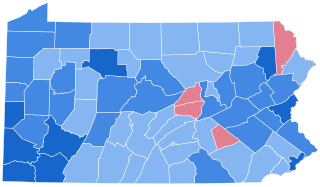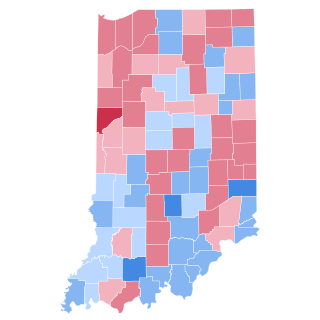
Albert Baird Cummins was an American lawyer and politician. He was the 18th governor of Iowa, elected to three consecutive terms and U.S. Senator for Iowa, serving for 18 years. Cummins was a leader of the Progressive movement in Washington and Iowa. He fought to break up monopolies. Cummins' successes included establishing the direct primary to allow voters to select candidates instead of bosses; outlawing free railroad passes for politicians; imposing a two-cent street railway maximum fare; and abolishing corporate campaign contributions. He tried, with less success, to lower the high protective tariff in Washington.

The 1900 New York state election was held on November 6, 1900, to elect the governor, the lieutenant governor, the Secretary of State, the state comptroller, the attorney general, the state treasurer and the state engineer, as well as all members of the New York State Assembly and the New York State Senate.

Claude Rodman Porter was an American politician and lawyer. He served in both chambers of the Iowa General Assembly and as a United States Attorney, and was a perennial Democratic Party runner-up to Republican victors in three races for governor of Iowa and six races for U.S. senator. In an era in which the Republican Party was so dominant in Iowa that Senator Jonathan P. Dolliver remarked that "Iowa will go Democratic when Hell goes Methodist," Porter twice came closer to winning the governorship than all but one other Democratic candidate of that era. He later served as a member of the U.S. Interstate Commerce Commission for eighteen years.

The 1964 United States presidential election in Pennsylvania took place on November 3, 1964, and was part of the 1964 United States presidential election. Voters chose 29 representatives to the Electoral College, who voted for president and vice president. Pennsylvania overwhelmingly voted for the Democratic nominee, President Lyndon B. Johnson, over the Republican nominee, Senator Barry Goldwater. Johnson won Pennsylvania by a margin of 30.22%. Apart from William Howard Taft in 1912, Goldwater's 34.7% of the vote is easily the worst showing for a Republican in the state since the party was founded. Even relative to Johnson's popular vote landslide, Pennsylvania came out as 7.64% more Democratic than the nation at-large; the only occasion under the current two-party system that the state has been more anomalously Democratic than this was in Ronald Reagan's 1984 landslide.

The 1916 United States presidential election in Montana took place on November 7, 1916 as a part of the 1916 United States presidential election. Voters chose four representatives, or electors to the Electoral College, who voted for president and vice president.

The 1934 Pennsylvania gubernatorial election occurred on November 6, 1934. Incumbent Republican governor Gifford Pinchot was not a candidate for re-election.

The 1916 United States presidential election in New York took place on November 7, 1916. All contemporary 48 states were part of the 1916 United States presidential election. Voters chose 45 electors to the Electoral College, which selected the president and vice president.

The 1920 United States presidential election in New Jersey took place on November 2, 1920. All contemporary 48 states were part of the 1920 United States presidential election. Voters chose 14 electors to the Electoral College, which selected the president and vice president.

The 1960 United States presidential election in Texas was held on November 8, 1960, as part of the 1960 United States presidential election. The Democratic Party candidate John F. Kennedy, narrowly won the state of Texas with 50.52 percent of the vote to the Republican candidate Vice President Richard Nixon's 48.52%, a margin of two percent, giving him the state's 24 electoral votes. Despite the presence of U.S. Senator Lyndon B. Johnson on the Democratic ticket, the result made Texas the tenth closest state in the election. Nixon's strong performance in the Dallas–Fort Worth Metroplex, Harris County, the Panhandle, and the Hill Country kept the race close.

The 1908 United States presidential election in North Carolina took place on November 3, 1908. All contemporary 46 states were part of the 1908 United States presidential election. North Carolina voters chose 12 electors to the Electoral College, which selected the president and vice president.

The 1916 United States presidential election in Indiana took place on November 7, 1916, as part of the 1916 United States presidential election which was held throughout all contemporary 48 states. Voters chose 15 representatives, or electors to the Electoral College, who voted for president and vice president.

The 1920 United States presidential election in Indiana took place on November 2, 1920, as part of the 1920 United States presidential election which was held throughout all contemporary 48 states. Voters chose 15 representatives, or electors to the Electoral College, who voted for president and vice president.

The 1922 Michigan gubernatorial election was held on November 7, 1922. Incumbent Republican Alex J. Groesbeck defeated Democratic nominee Alva M. Cummins with 61.15% of the vote.

The 1916 United States presidential election in South Dakota took place on November 7, 1916, as part of the 1916 United States presidential election in which all contemporary forty-eight states participated. Voters chose five electors, or representatives to the Electoral College, who voted for president and vice president.

The 1906 Iowa gubernatorial election was held on November 6, 1906. Incumbent Republican Albert B. Cummins defeated Democratic nominee Claude R. Porter with 50.18% of the vote.

The 1903 Iowa gubernatorial election was held on November 3, 1903. Incumbent Republican Albert B. Cummins defeated Democratic nominee J. B. Sullivan with 57.14% of the vote.

The 1912 Indiana gubernatorial election was held on November 5, 1912. Democratic nominee Samuel M. Ralston defeated Progressive nominee Albert J. Beveridge and Republican nominee Winfield T. Durbin with 42.95% of the vote. The vote splitting between the Republican and Progressive nominees benefited Democrat Ralston tremendously in this election.

The 1932 Wisconsin gubernatorial election was held on November 8, 1932. Incumbent Republican Governor Philip La Follette was defeated in the Republican primary, and in the midst of the Great Depression and nationwide voter dissatisfaction with the Republican Party, Democratic nominee Albert G. Schmedeman defeated Republican nominee Walter J. Kohler Sr. and Socialist nominee Frank Metcalfe with 52.48% of the vote. Schmedeman became the first Democrat to win a gubernatorial election in Wisconsin since George Wilbur Peck in 1892. Two years later, in 1934, La Follette would run for governor again and defeated Schmedeman, this time running with the Progressive Party.

The 1908 Illinois gubernatorial election was held on November 3, 1908. It saw the election of Republican nominee John G. Oglesby.

Alva Marvin Cummins was an American lawyer. Cummins was admitted to the bar in 1891. From there, he went on to serve in leadership positions at multiple bar associations. Cummins also had a political career marked by several electoral defeats. Cummins was nominated by the Democratic party for positions such as congressman, governor, and state attorney general.























